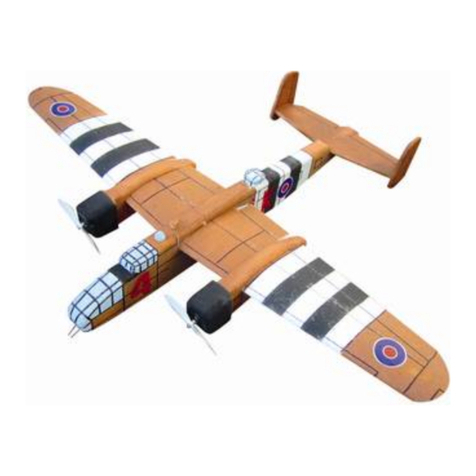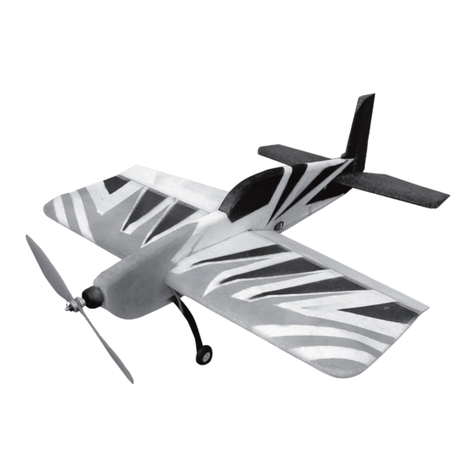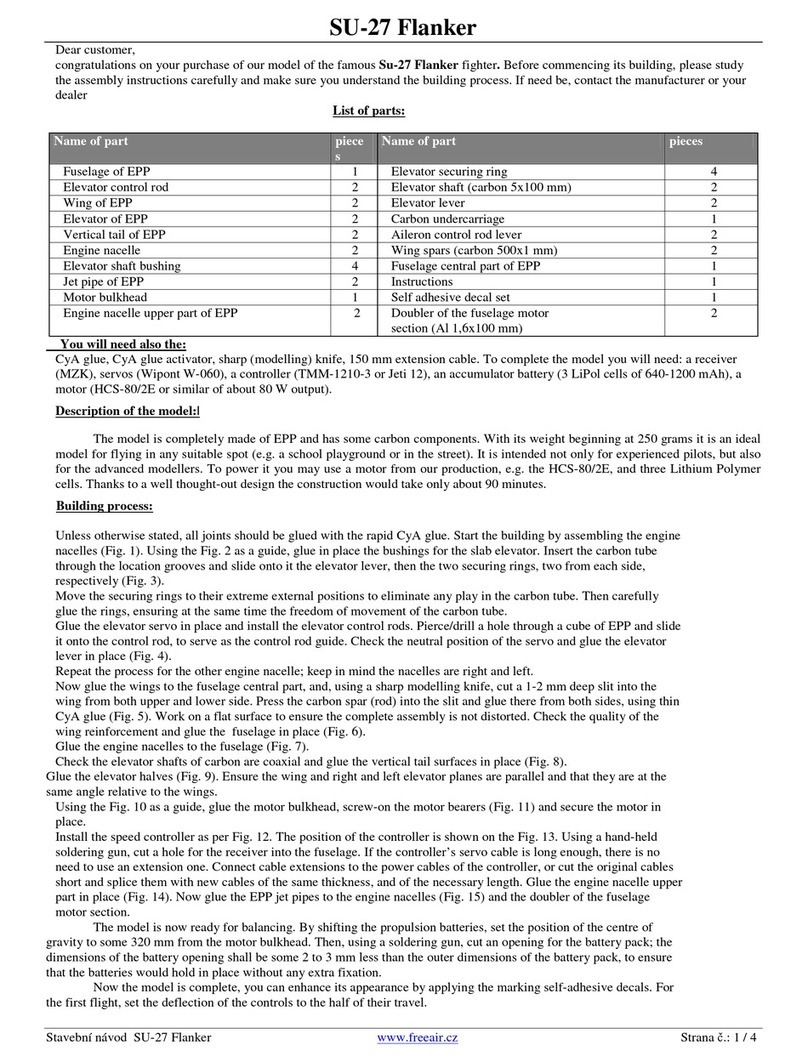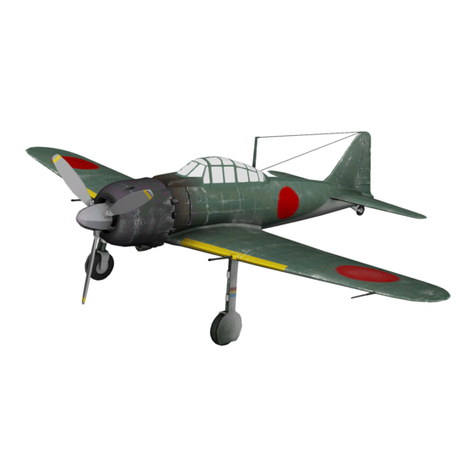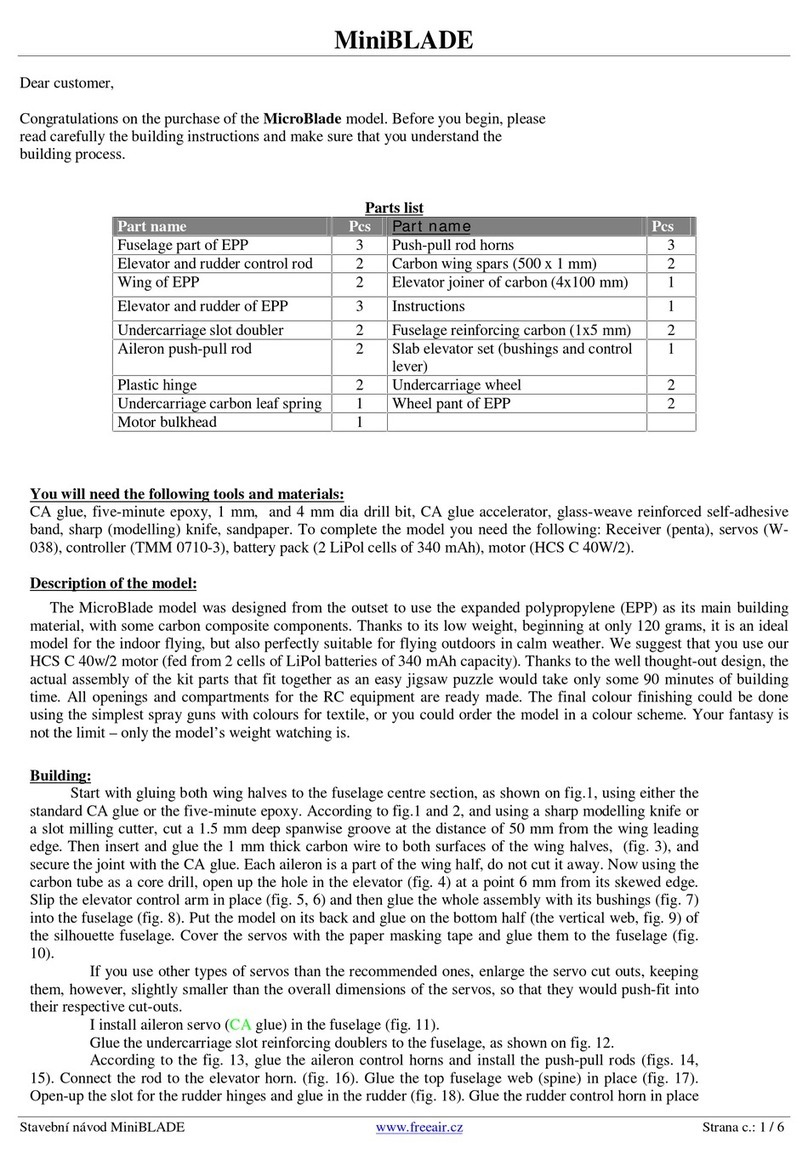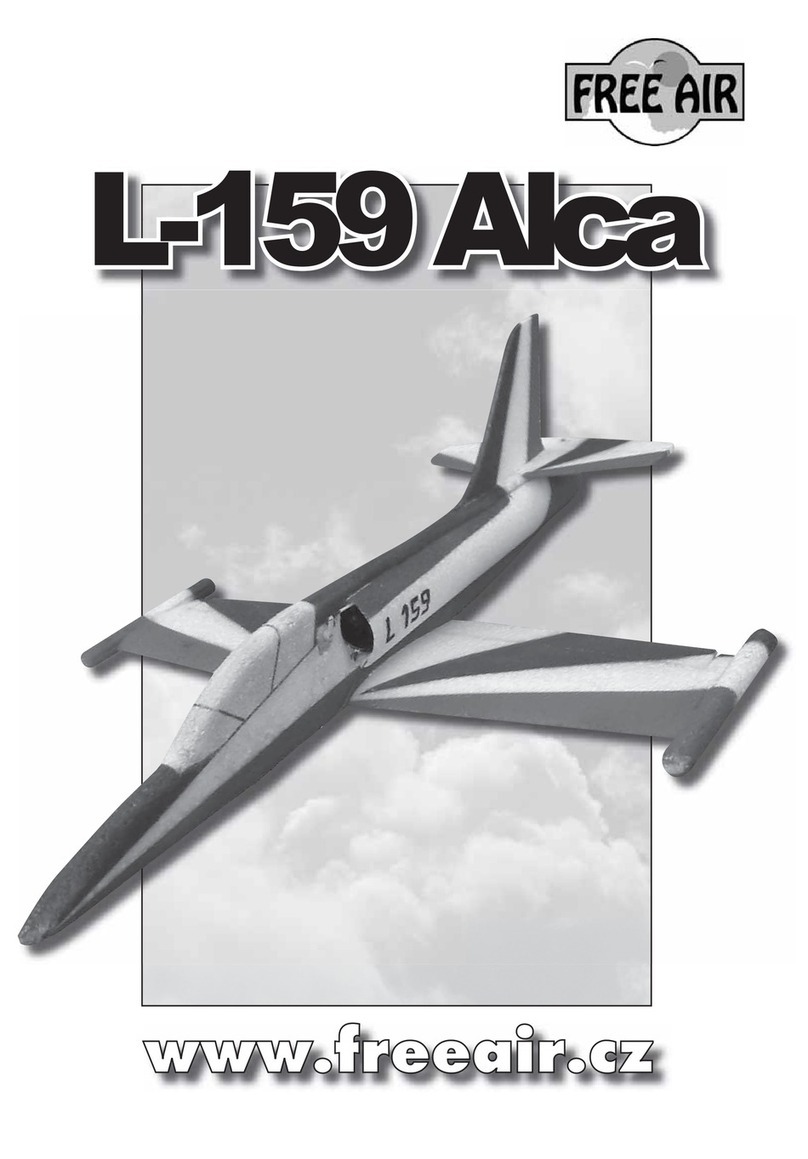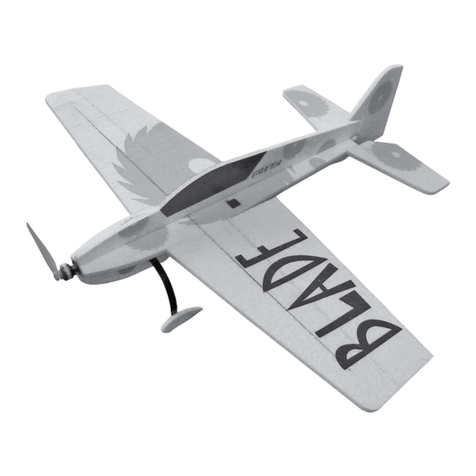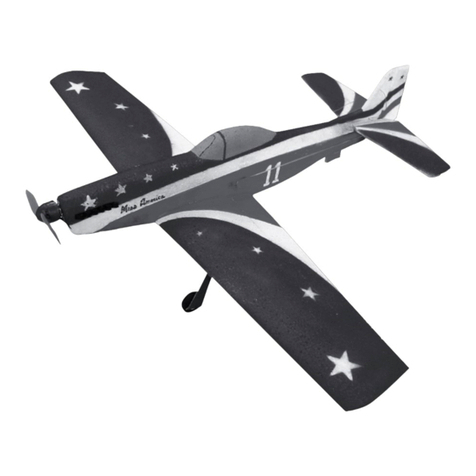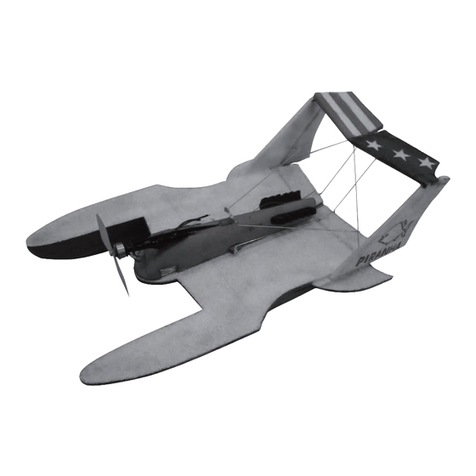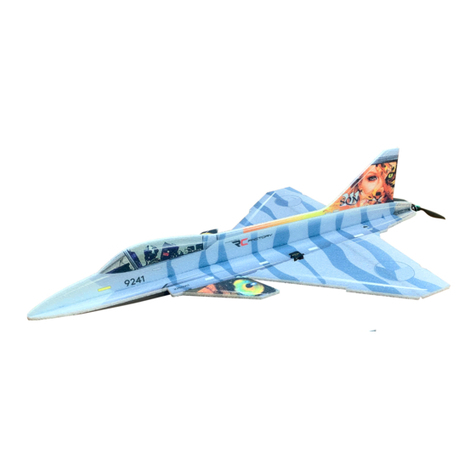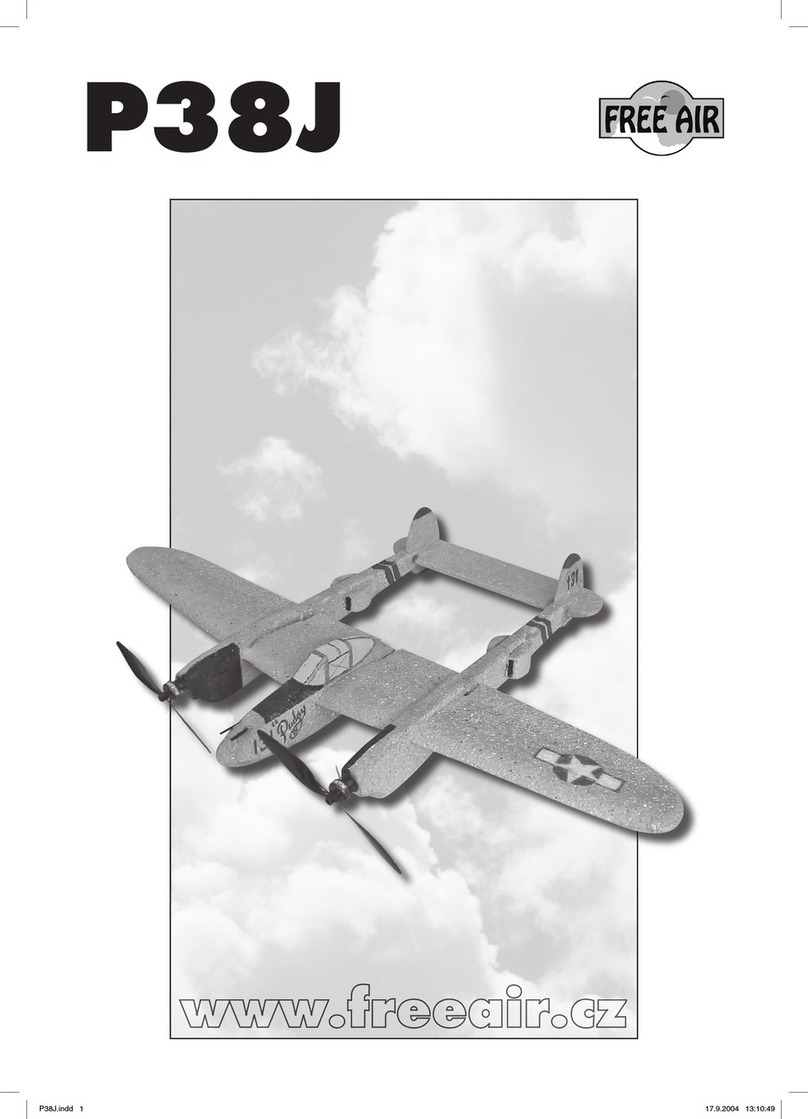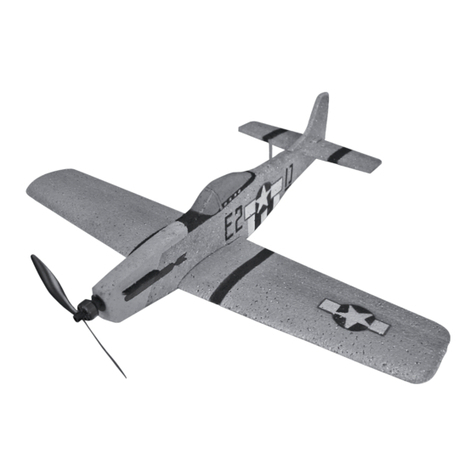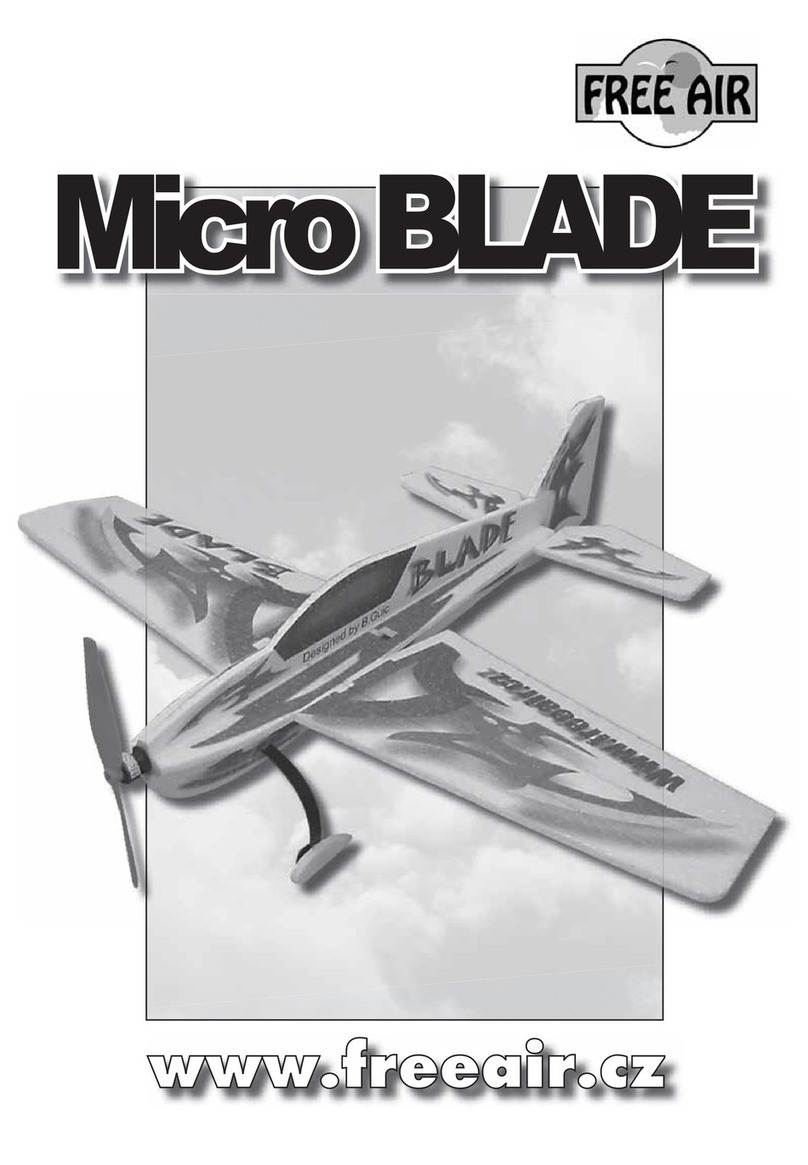
Jak 55
Gratulujeme! Stali jste se šťastnými majiteli špičkového 3D akrobatického modelu Jak 55 vyrobeného z EPP metodou
prostorového trupu. Tato technologie – podobná stavběpapírového modelu zaručuje vysokou pevnost a dobré letové vlastnosti při
zachování nízké letové hmotnosti důležité pro létání 3D akrobacie.
Obsah stavebnice
Název počet Název počet
Trup z EPP 1 Stojina křídla (1x1000mm) 2
Páteřz EPP 1 Kola 35mm 2
Křídla z EPP 2 Táhla - Al drat 1,6mm 4
Výškové kormidlo z EPP 1 Ostruha Al drat 1,6mm 1
Směrové kormidlo z EPP 2 Podvozek uhlík 1
CNC-frézovaná sada příslušenství 2 Osy kol M2x20 2
Přepážky z EPP 4 MatičkyM2 4
Lože podvozku z EPP 1 EPP destička 1
Kabina plexi 1
Dráty uchycení kabiny 2 Stavební návod 1
Motorová přepážka překližka 1
Ke stavběbudete potřebovat.: vteřinové CA lepidlo, urychlovačCA lepidla, skalpel, pravítko, brusnou mřížku na sádru
RC vybavení: 4ks serva 6g (Waypoint 060), 4 ks prodlužovacích kabelů, přijímač5 kanál (MZK Penta), AC regulátor 12-25A,
AC motor 100-200W (HCS 150W), vrtule (GWS) 10/6, 11/4.
Stavba: Veškeré spoje lepíme pomocí řídkého vteřinového lepidla. V první fázi spoje jen pojistíme tak, aby držely u sebe a
následněpo kontrole pozice a souměrnosti je zalepíme. Dáváme při tom pozor na to, aby lepidlo neproteklo skrz EPP a
nepřilepili jsme si prsty ke konstrukci.
Křídla: Křídla slepíme v ose profilu k páteři trupu.Obr 1. Z přiložené destičky EPP vyřízneme stojinu na spodní i horní stranu
páteře a přilepíme.Obr 2,3,4,5. Na horní i spodní straněkřídla v místěstojiny zařízneme drážku pro uhlík 1mm. Uhlík do drážky
zatlačíme zkontrolujeme rovinu a zalepíme.Obr 6,7,8,9
Trup: Do páteře zalepíme přepážky a pomocnou tvarovou výztuhu podvozku.Obr 10,11,12. Na trupu zalepíme přední spodní
tvarový výstřih.Obr13. Trup stočíme, zajistíme páskou a necháme alespoň30 min přetvarovat. Obr14,15. Vtrupu jsou
předfrézovaná zahloubení pro zámečky páteře. Z nich odstraníme přebytečné EPP tak abychom nepoškodili vnější povrch trupu.
Obr16,17. Trup rozřízneme od náběžné hrany křídla k bočnímu tvarovému výstřihu.Obr 18,19. Trup navlékneme na páteř,
nasadíme na zámečky páteře a pomocí např. špendlíkůzafixujeme.Obr 20. Bodověpřilepíme k páteři. Tato operace je na celé
stavběnejnáročnější. Musíme kontrolovat zda není trup ohnutý nebo překroucený. V případěchyby lepené body odřízneme a
chybu odstraníme. Teprve poté páteřpřilepíme po celé délce.Obr 21,22. V přední části přilepíme trup ke křídlům a slepíme
rozříznuté boky. Obr 23. Přilepíme spodní část přední přepážky. Přepážky podvozku prozatím nelepíme. Poté slepíme přední
horní část trupu a zbylé tvarové výstřihy.Obr24,25. Přilepíme horní část přední přepážky. Na závěr slepíme zadní horní část trupu
od kabiny ke směrovce.Obr 26. Konce bočnic stlačíme k soběa slepíme.
Kormidla: Do zářezu zasuneme výškovku, zkontrolujeme souosost s křídlem a přilepíme. Na horní části trupu pod
stabilizátorem směrovky obroušením vytvoříme plošku pro přilepení stabilizátoru směrovky a stabilizátor přilepíme.Obr 27,28.
Pohyblivá část směrovky je zavěšena na skleněných pantech (6ks) z nichž jeden tvoří páku . Osou je Al drát 1,6mm protažený
skrz panty a zapíchnutý do směrovky.Obr 29,30,31,32. Panty zařízneme, vyzkoušíme pohyblivost a zalepíme.Obr 33,34.
Výchylky kormidel můžeme ještěupravit zvětšením výřezůve směrovce i výškovce. Obr35.
Osazení serv: Pro dosažení potřebných výchylek kormidel i křidélek použijeme prodlužovaní páky na serva. Ty navlékneme na
stávající páku serva a zalepíme. Obr36. Prodloužíme přívodní kabely. V křídlech vyřežeme otvory a do nich zatlačíme
serva.Obr37. Kabely s prodlužováky zařízneme do křídla.Obr38. Protáhneme do trupu v místěkabiny Obr 39. Do křidélka
zařízneme páky a spojíme se servy táhlem pomocí „Z“ohybu (Al drát 1,6 mm).Obr40. Do bočnic před náběžnou hranou výškovky
vyřízneme otvory a do nich zasuneme serva kormidel. Obr41 Do výškovky zařízneme a zalepíme skleněnou páku. Serva spojíme
s pákami táhlem (Al drát 1,6mm). Zapojíme a vyzkoušíme. Serva zalepíme. Obr42
Podvozek: V podvozku vyvrtáme dírky pro osičky kol (šroub M2). Kola přišroubujeme Obr43. Trup v místězesílení mezi
přepážkami podvozku vyřízneme. Vsadíme, seřídíme a přilepíme podvozek i přepážky. Obr44. Překryjeme vyříznutým kusem a
ten také přilepíme.Obr45 Pod kormidla zalepíme ostruhu z drátu.Obr46,47.
Motor: Motor s připojeným regulátorem přišroubujeme do motorové přepážky, bez vrtule vyzkoušíme směr otáčení a přepážku
zasuneme a lehce přilepíme do trupu. Obr 48. Vyosení motoru by mělo být 2-4 stupnědoprava dle použité vrtule. Vyosení je
třeba doladit až při zalétání (zavisení).
Kabina: Kabinu vystřihneme tak aby na ní zůstal lem cca 1cm. Samolepící páskou – nejlépe modré barvy ji olemujeme a
vyznačíme přepážky. Kabinu připasujeme na trup a z jednoho boku v lemu kabiny uděláme dvědíry 1,6mm. Skrz tyto otvory do
bočnice zabodneme dva Al dráty které propíchneme na druhou stranu trupu. Místa výstupu drátůsi označíme na druhém lemu
kabiny. Dle označení vyvrtáme díry 1,6mm.Obr49. Dráty do bočnic zalepíme a tím zpevníme bočnice v místěkabiny.
Baterie: Bateriemi měníme těžištěmodelu. Na páteřv přední části nalepíme pruh suchého zipu(chlupy). Na baterie nalepíme
protikus suchého zipu (háčky). Baterie vkládáme kabinou. Při zalétání můžeme posunem baterií najít ideální těžištěpro náš styl
létání.
Těžiště: těžištěje 90mm od náběžné hrany křídla.
Zalétání: Při zalétávání postupujeme jako u jiného akrobatického modelu.
Mnoho šťastných visení, harrierů, nožových letůa jiných skopičin přeje Free Air
Manual Jak55 www.freeair.cz Page nr..: 1 / 1




